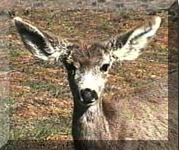
Stripe Deer



 Description: Stripe Deer have large ears that move constantly and independently. They do not run as other deer, but have a peculiar and distinctive bounding leap over distances up to 8 yards, with all 4 feet coming down together. In this fashion, they can reach a speed of 45 M.P.H. for short periods.
Description: Stripe Deer have large ears that move constantly and independently. They do not run as other deer, but have a peculiar and distinctive bounding leap over distances up to 8 yards, with all 4 feet coming down together. In this fashion, they can reach a speed of 45 M.P.H. for short periods.
This stocky deer with sturdy legs is 4 to 6-1/2 feet in length and 3 to 3-1/2 feet high at the shoulder. During the summer, the coat on its upper body is yellow- or reddish-brown, while in winter more gray, with thin white stripes running down its back. The throat patch, rump patch, inside ears and inside legs are white with lower portions running cream to tan. A dark V-shaped mark, extending from a point between the eyes upward and laterally is characteristic of all Stripe Deer but is more conspicuous in males.
Males are larger than females. The bucks' antlers, which start growth in spring and are shed each year in the winter, are high and branch forward, forking equally into 2 tines with a spread up to 4 feet.
The Stripe Deer is slower and less colorful than the White-tailed Deer, but its pastel, gray-buff color provides a physical adaptation to the desert environment which disguises it from predators like the Desert Tiger, the Jackal and the eagle who will swoop down on a fawn.
Stripe Deer have no canine teeth and, like the cow, have a multi-part stomach, the first two chambers of which act as temporary storage bins. Food stored here can be digested later when the deer chews its cud.
Vocalization: Deer are not especially vocal, although young fawns bleat on occasion. Injured deer utter a startlingly loud "blatt" or bawl.
Tail: The tail is usually tipped in black with a white basal portion, and its under parts are white.
Ears: The Stripe Deer large ear is gray on the outside and white on the inside. Their hearing is extremely good.
Feet: Another physical adaptation, its larger feet, allows the Stripe Deer to claw out water as much as two feet deep, which it detects with its keen sense of smell.
Behavior: Seasonal movements involving migrations from higher elevations (summer ranges) to lower winter ranges.
When startled, a Stripe Deer will move in a series of stiff-legged jumps with all four feet hitting the ground together. This gait offers two advantages: it allows the deer to out-distance predators in rough terrain, and to see above the thick brush. If necessary, they can turn or completely reverse direction in the course of a single bound.
Stripe Deer are active primarily in mornings, evenings and moonlit nights. This inactivity during the heat of the day is a behavioral adaptation to the desert environment that conserves water and keeps the body temperature within livable limits. Sweat glands and panting also provide evaporative cooling during hot periods.
During the middle of the day, the Stripe Deer beds down in a cool, secluded place. The mature buck seems to prefer rocky ridges for bedding grounds, while the doe and fawn is more likely to bed down in the open.
Food & Hunting: Food of the Stripe Deer is quite varied. In Spring and Summer it feeds on green leaves, herbs, weeds and grasses more than on browse species. The reverse is true in Fall and Winter.
Stripe Deer are browsers and eat a great variety of vegetable matter, including fresh green leaves, twigs, lower branches of trees, and various grasses. They eat so carefully they can even consume the fruit of cactus.
Breeding: The mating season for Stripe Deer reaches its peak in winter months, as antlered stags round up females and fight for their possession. Antlers are shed after the breeding season, from late winter to early spring. Most mature bucks in good condition have lost theirs by the end of winter; immature bucks generally lose them a little later. Males and females mix freely while traveling together in groups during winter months.
Dominance is largely a function of size, with the largest males, which possess the largest antlers, performing most of the copulations
Stripe Deer breed in late winter. A buck will find a suitable doe and they will often play chase games at breakneck speeds before mating. They will remain together for several days.
When antlers start growing again in the spring, the group breaks up. The females go off by themselves and eventually give birth and nurse their young; the males wander in friendly twosomes or small bands throughout the summer months as antlers grow.
During early summer the doe delivers 1 to 4 young (normally 2). A doe will usually produce a single fawn the first year she gives birth and then produce twins in following years. The fawn, colored reddish with white spots, weighs about 6 pounds at birth. It must nurse within the first hour and stand within the first 12 hours. During early weeks of life, the fawn sees its mother only at mealtimes for feeding. Spots begin to look like stripes by the end of the first month. They have white camouflage spots and are further protected by having little or no scent. Fawns usually stay with the doe for the first full year.
Life span in the wild is 10 years, but Stripe Deer have lived up to 25 years in captivity .
Uses: Striped deer are used by the elves not only for meat but also their hides, which are used to make leather articles of clothing. One of the main sources of protein for the Holt.